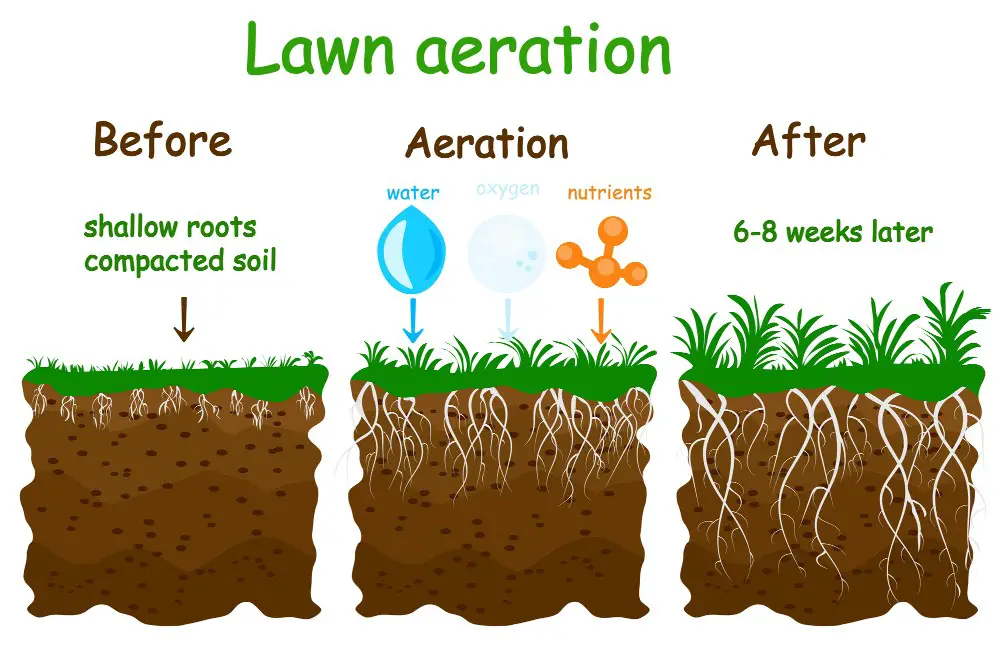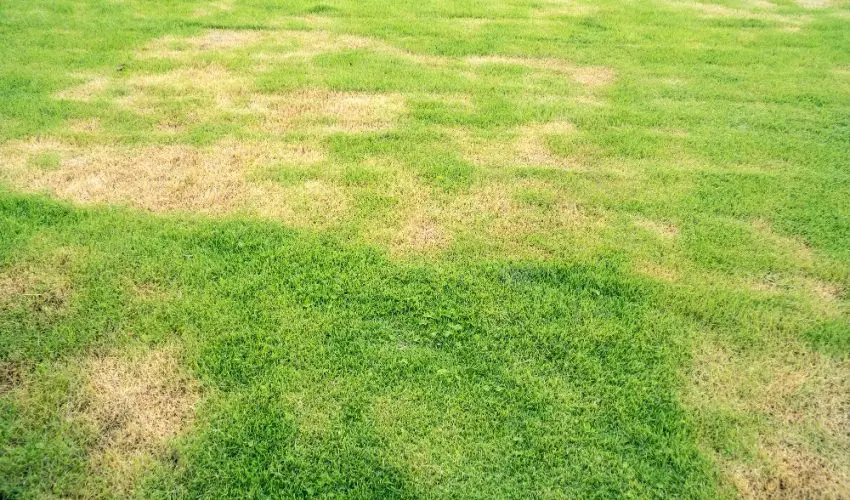Dry spots in your lawn can be incredibly frustrating, and can happen even if you’re taking good care of your grass. But, there are a few things you can do to fix dry spots in your lawn.
Table of Contents
ToggleKeep on reading to get my best tips on how to deal with dry spots in your lawn.
How to identify dry patches in your lawn
The most common sign of dry patches in your lawn is visible bare spots or thinning and yellowing grass. You should also check for areas that has low grass blades, as this could be a sign of dry soil.
As the bare soil is exposed to sun, it become dry and hard which making it difficult for the grass to absorb water and nutrients from the soil. This leads to increasing dryness in the area.
Common causes of dry patches in your lawn
Dry patches in lawns are usually caused by heat exposure that causes the soil to become hydrophobic. This means that it is unable to absorb water, leading to dry spots on your lawn.
Common causes of dry patches in your lawn might not only be the result of a lack of water, but can also be caused by pet urine. Pet urine is very high in nitrogen which is essential for plant growth, but can also be harmful in large quantities. Dog urine is also acidic, and when it comes into contact with the grass, it can create a chemical burn effect, which causes the grass to turn yellow or brown and eventually die.
How to Fix Dry Patches in Your Lawn
Fixing dry patches in your lawn can be a challenging task, and there are several methods to address this issue. But in my experience these are the 3 best ways to solve the problem:
1. Aerate the Soil
Aeration plays a significant role in soil health, especially when dealing with dry patches in your lawn. This process involves perforating the soil with small holes to allow water, nutrients, and air to penetrate and nourish the grass roots.

You can aerate using a garden fork or specialized tools like aerator sandals or an electric dethatcher if that suits you better. The choice of tool will depend on your lawn size and the severity of the dry patches.
Aeration is much easier and effective when the soil is moist. That’s why it’s recommended to deep watering before aerating if the lawn is too dry.
2. Apply a Wetting Agent
After aeration, the next step is to apply a wetting agent to the dry patches. A wetting agent, such as Penterra Soil Penetrant and Wetting Agent, is a substance that enhances the soil’s ability to absorb and retain water. It works by reducing the surface tension of water, enabling it to spread out and penetrate deeper into the soil.
Wetting agents come in various forms, including granules and liquids. Once applied, ensure you water the lawn thoroughly. This helps the agent to distribute evenly and boosts the soil’s ability to retain moisture in a usable form for an extended period.
3. Replace the Turf and Soil of the Affected Area
In severe cases, when the tips above do not give you good results you might need to replace the turf and the top 3-4 inches of soil in the affected area.
This method involves digging out the damaged lawn and the underlying soil and replacing it with fresh soil and reseeding or re-laying with fresh turf. This can be a more drastic measure, but it may be necessary for particularly stubborn dry patches resistant to other treatment methods.
How to Prevent Dry Patches in Your Lawn
The best way to get rid of dry patches in your lawn is to prevent them from forming in the first place.
1. Opt for Drought-Tolerant Lawn Grass
Choosing drought-tolerant grass varieties can be a great first step to prevent dry patches. These grass varieties have adapted to survive in conditions with less water, making them less likely to develop dry patches during periods of low rainfall or intense heat. Some examples include Bermuda grass, Buffalo grass, and Tall Fescue.
2. Employ Proper Watering Techniques
Overwatering or underwatering can lead to dry patches in your lawn. It’s essential to water your lawn deeply but infrequently. This method encourages the development of deep roots, which are more capable of accessing water stored deeper in the soil during dry spells.
If possible, water your lawn early in the morning when evaporation rates are lower, and ensure the water penetrates about 4-6 inches into the soil. Using an efficient irrigation system or sprinkler can also help distribute water evenly across your lawn.
3. Regular Aeration and Application of Wetting Agents
As discussed earlier, aerating the soil and applying a wetting agent can drastically improve the soil’s water retention capability. Making this a part of your regular lawn maintenance routine can help prevent the formation of dry patches.
4. Proper Fertilization
Using a balanced NPK (Nitrogen, Phosphorus, Potassium) fertiliser can help maintain healthy grass that is less prone to drying out. Apply fertilizers at the recommended rates and at the right time, usually during the active growing seasons for your particular type of grass.
5. Appropriate Mowing Practices
Proper mowing can significantly improve the health of your lawn. Set your mower blade to a higher setting to keep your grass slightly longer. Longer grass blades can shade the soil, reducing evaporation and helping to keep the roots cooler and moister.
Other Causes of Dead Spots in Grass
While water management and soil conditions can significantly contribute to the formation of dry patches or dead spots in your lawn, other factors can play a role too. Here are two often overlooked causes:
Urine Burns from Pets
If you have pets, especially dogs, you may notice discoloration or dead spots in the areas they frequently urinate. This happens due to the high nitrogen content present in their urine, which can ‘burn’ the grass.
One way to solve this problem is to train your dog to use a specific area of your yard for their business to prevent widespread damage. Additionally, products like Dog Rocks can be used in your dog’s water bowl to neutralize the nitrogen levels in their urine, thereby reducing its harmful effect on your lawn.
Pests
Another common cause of brown patches in your lawn could be pests like Chafer Grubs, Leatherjackets, or sod webworms. These insects feed on the roots of the grass, causing it to brown and die. If you notice irregular brown patches coupled with signs of insect activity, consider seeking the help of a lawn care professional for proper pest identification and control measures.
Conclusion
Caring for a lawn involves much more than regular watering and mowing. Dry patches or dead spots can be a sign of various underlying issues ranging from soil compaction, inadequate water penetration, to pet urine burns and pest infestations.
The good news is that each of these problems has a solution. By taking the time to properly aerate your lawn and using wetting agents, you can fix dry patches and prevent them from coming back in the future.





